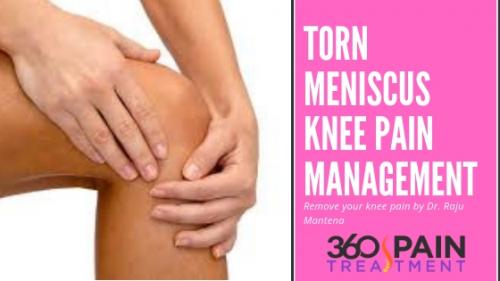Torn Meniscus – Knee Pain Management

The meniscus tear is a debilitating and painful condition. Meniscus tears are the most commonly occurring cartilage injuries of the knee. The meniscus is the cartilage that cushions the thighbone (femur) and the shinbone (tibia).
Two menisci are found in each knee joint. The meniscus protects the knee bones from wear and tear. A torn meniscus will cause swelling, stiffness, and considerable pain. Most people suffering from this condition have trouble extending the knee fully.
Dr. Raju Mantena provides comprehensive diagnosis and uses 360 Pain Treatment to resolve the torn meniscus pain completely. The holistic treatment plan is customized as per the specific requirements of the patient.
Symptoms
The symptoms of a meniscus tear include:
-
Swelling and pain in the knee.
-
Locking or catching of the knee.
-
Difficulty straightening and bending the knee.
-
A popping sensation in the knee during injury.
-
Pain when rotating or twisting the knee.
-
Limited motion of the knee joint.
Causes
The meniscus is often torn during activities that put immense pressure on the knee. Heavy lifting, deep squatting or a sudden turn or pivot can cause injury to the cartilage.
Sports activities (basketball, tennis, football) increase the risk of meniscus tears. Meniscus tears are also becoming common among children. This is due to the active participation of children in sports activities.
Preventing Meniscus Tear
The meniscus tear is often difficult to prevent as they usually occur due to an accident. You will be able to lower the risk of knee injury by including:
-
Warm up routine before strenuous sports activities.
-
Keep the thigh and knee muscles strong with regular stretches and exercises.
-
Ensure shoes fit correctly. The shoes should also provide adequate support to the foot.
Treatment
The treatment of the meniscus tear will depend on the location and size of the tear. The other factors that influence treatment include activity level, age, and other injuries.
Non-Surgical Treatment
If the tear is on the outer edge of the meniscus or small it will not require surgery. Small tears often heal on their own.
-
Avoid activities that aggravate the pain and swelling. Crutches can be used to avoid putting weight on the affected leg.
-
Apply ice packs to the affected area several times a day. Avoid applying ice directly on the skin. This will help reduce inflammation and pain.
-
Wearing an elastic compression bandage will prevent blood loss and swelling.
-
Elevate the leg higher than the heart to reduce swelling.
-
Anti-inflammatory medications will provide relief from pain. The medications should be used only under the supervision of the pain management doctor.
-
Stretching exercises will strengthen the muscles and reduce strain on the knee.
Surgery
If the meniscus tear is large, surgery is recommended to repair it. Arthroscopic surgery is the most common knee surgical procedure. The surgeon stitches the torn pieces together. The recovery time will depend on the type of tear that is fixed.
Dr. Raju Mantena uses the best diagnostic approaches and innovative treatment procedures to relieve pain in the quickest and most effective manner possible. 360 Pain Treatment will help improve the quality of life of patients.
Post Your Ad Here
Comments